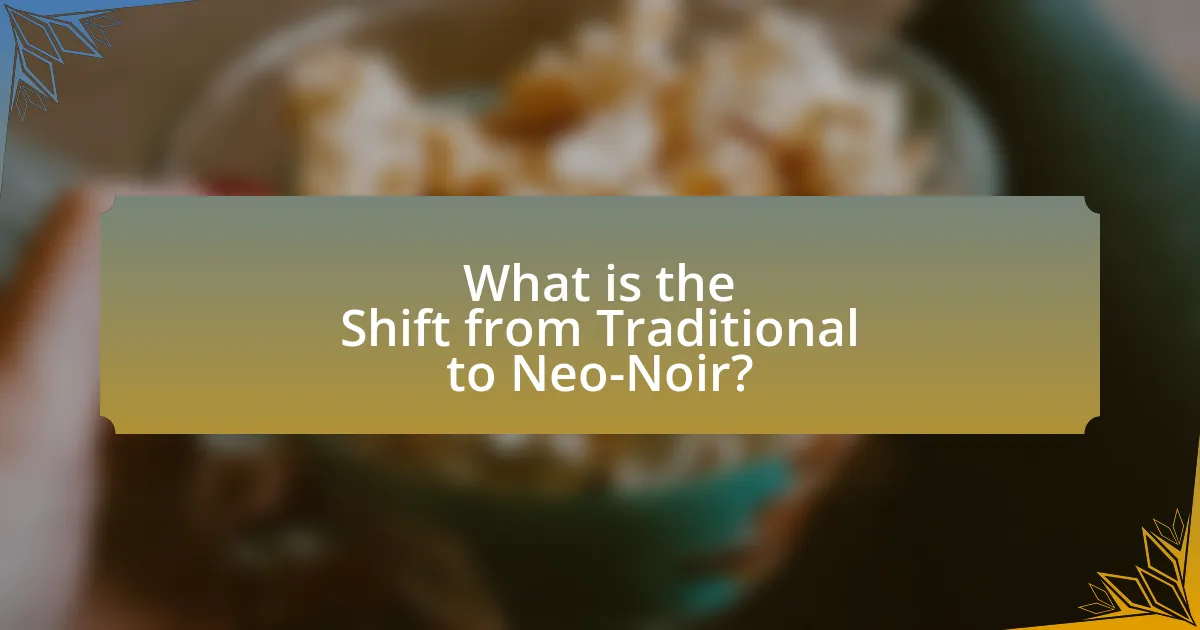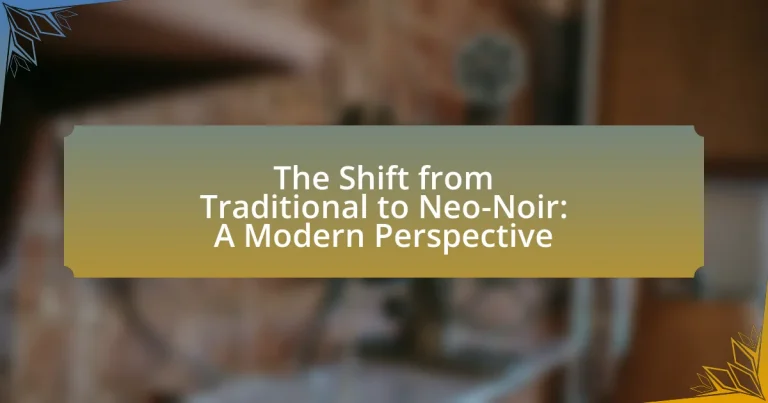The article examines the transition from traditional noir to neo-noir, highlighting the evolution of cinematic storytelling that incorporates contemporary themes, aesthetics, and moral ambiguity. It outlines how traditional noir established foundational elements such as crime, moral dilemmas, and a distinct visual style, which neo-noir filmmakers adapted to reflect modern societal issues like technology and psychological complexity. Key characteristics of both genres are discussed, including the influence of societal changes and globalization on neo-noir narratives, as well as the significance of modern technology in shaping contemporary storytelling. The article also addresses how audience expectations have shifted, emphasizing the demand for complex narratives and morally ambiguous characters in today’s cinematic landscape.

What is the Shift from Traditional to Neo-Noir?
The shift from traditional to neo-noir represents a transformation in cinematic storytelling that incorporates contemporary themes, aesthetics, and moral ambiguity. Traditional noir, prevalent in the 1940s and 1950s, focused on crime, moral dilemmas, and a distinct visual style characterized by high contrast and shadowy cinematography. In contrast, neo-noir, emerging in the late 20th century, adapts these elements to reflect modern societal issues, such as existentialism, technology, and psychological complexity. For instance, films like “Blade Runner” and “Chinatown” illustrate this evolution by blending classic noir motifs with futuristic settings and intricate character development, showcasing a departure from the straightforward narratives of traditional noir.
How did Traditional Noir influence the emergence of Neo-Noir?
Traditional Noir significantly influenced the emergence of Neo-Noir by establishing foundational themes, stylistic elements, and character archetypes that Neo-Noir filmmakers adapted and reinterpreted. Traditional Noir, characterized by its moral ambiguity, femme fatales, and hard-boiled detectives, set a precedent for storytelling that explored the darker aspects of human nature and societal corruption. Neo-Noir filmmakers, such as those in the 1970s and beyond, incorporated these elements while also integrating contemporary issues, advanced cinematography, and a more complex narrative structure. For instance, films like “Chinatown” and “Blade Runner” reflect the stylistic and thematic legacies of Traditional Noir while addressing modern existential dilemmas and technological anxieties. This evolution illustrates how the core principles of Traditional Noir provided a blueprint for Neo-Noir, allowing it to resonate with new audiences while maintaining a connection to its predecessor.
What are the defining characteristics of Traditional Noir?
Traditional Noir is characterized by its dark, cynical tone, morally ambiguous characters, and a focus on crime and existential despair. The genre often features a hard-boiled detective or anti-hero navigating a corrupt society, emphasizing themes of fate, betrayal, and the darker aspects of human nature. The visual style is marked by high-contrast lighting, shadowy settings, and a sense of claustrophobia, which enhances the mood of paranoia and tension. These elements collectively create a narrative that reflects the disillusionment of post-World War II America, as seen in classic films like “Double Indemnity” and “The Maltese Falcon.”
In what ways did Traditional Noir set the stage for Neo-Noir?
Traditional Noir established foundational themes and stylistic elements that Neo-Noir later adopted and adapted. Key aspects include the exploration of moral ambiguity, complex characters, and a focus on psychological depth, which became hallmarks of Neo-Noir. Traditional Noir’s use of visual aesthetics, such as low-key lighting and urban settings, influenced the visual style of Neo-Noir films. Additionally, the narrative structure of Traditional Noir, often featuring a femme fatale and a flawed protagonist, set a precedent for Neo-Noir storytelling, allowing for a modern reinterpretation of these archetypes. The evolution of societal issues, such as disillusionment and existential dread, further bridged the gap between the two genres, making Neo-Noir a contemporary reflection of the themes first explored in Traditional Noir.
What are the key features of Neo-Noir?
The key features of Neo-Noir include a focus on moral ambiguity, complex characters, and a stylized visual aesthetic. Neo-Noir often presents protagonists who are flawed and morally compromised, reflecting the complexities of modern society. The narratives typically involve themes of existentialism, paranoia, and social critique, diverging from the clear-cut morality found in traditional film noir. Additionally, Neo-Noir employs modern cinematographic techniques, such as high-contrast lighting and unconventional camera angles, to create a visually striking atmosphere that enhances the storytelling. These elements collectively distinguish Neo-Noir from its predecessor, emphasizing a more nuanced and contemporary approach to the genre.
How does Neo-Noir differ from Traditional Noir in themes and aesthetics?
Neo-Noir differs from Traditional Noir primarily in its themes and aesthetics by incorporating contemporary issues and a more diverse visual style. Traditional Noir, prevalent in the 1940s and 1950s, often focused on themes of moral ambiguity, fatalism, and the darker aspects of human nature, typically set against a backdrop of urban decay and featuring a monochromatic color palette. In contrast, Neo-Noir, emerging in the late 20th century, explores modern societal concerns such as technology, identity, and psychological complexity, often utilizing vibrant colors, innovative cinematography, and a mix of genres. For example, films like “Blade Runner” and “Fight Club” showcase these modern themes and aesthetics, reflecting a shift in cultural narratives and visual storytelling techniques.
What role does modern technology play in Neo-Noir narratives?
Modern technology serves as a critical element in Neo-Noir narratives by enhancing themes of alienation, surveillance, and moral ambiguity. In these narratives, technology often acts as a double-edged sword, facilitating both the pursuit of truth and the perpetuation of deception. For instance, the use of smartphones and social media can amplify the sense of paranoia and mistrust among characters, reflecting contemporary societal anxieties. Additionally, advancements in surveillance technology, such as CCTV and data tracking, create a pervasive atmosphere of observation that influences character behavior and plot development. This integration of modern technology not only updates the aesthetic of traditional Noir but also deepens the exploration of ethical dilemmas, as seen in films like “Blade Runner 2049,” where technology shapes the characters’ identities and moral choices.

Why is the Shift from Traditional to Neo-Noir significant?
The shift from traditional to neo-noir is significant because it reflects evolving societal values and cultural anxieties. Traditional noir, characterized by its moral ambiguity and fatalism, often mirrored post-war disillusionment, while neo-noir incorporates contemporary themes such as technology, identity, and social justice. This evolution allows filmmakers to address modern issues, such as systemic corruption and psychological complexity, making the genre more relevant to today’s audiences. For instance, films like “Blade Runner” and “Chinatown” illustrate how neo-noir adapts classic elements to critique modern society, thus reinforcing its significance in cinematic history.
What cultural factors contributed to the rise of Neo-Noir?
The rise of Neo-Noir was significantly influenced by cultural factors such as societal disillusionment, the evolution of gender roles, and advancements in technology. Societal disillusionment, particularly following events like the Vietnam War and Watergate scandal, fostered a sense of cynicism and distrust in authority, which is a hallmark of Neo-Noir narratives. The evolution of gender roles, especially the emergence of strong female characters, reflected changing societal attitudes towards feminism and sexuality, contrasting with the more traditional portrayals in classic Noir. Additionally, advancements in technology, including the rise of digital media and the internet, allowed for new storytelling techniques and broader access to diverse narratives, further enriching the Neo-Noir genre. These cultural shifts collectively shaped the thematic and stylistic elements that define Neo-Noir today.
How have societal changes influenced Neo-Noir storytelling?
Societal changes have significantly influenced Neo-Noir storytelling by reflecting contemporary issues such as urban decay, moral ambiguity, and the complexities of modern relationships. As society has evolved, particularly through the late 20th and early 21st centuries, themes of disillusionment and existential dread have become more prominent in Neo-Noir narratives, mirroring the anxieties of a post-industrial world. For instance, the rise of technology and surveillance has introduced new elements of paranoia and distrust, evident in films like “Blade Runner 2049,” which explores the implications of artificial intelligence and corporate control. Additionally, the increasing focus on diverse perspectives and social justice has led to more complex characters and narratives that challenge traditional gender and racial stereotypes, as seen in works like “Gone Girl,” which critiques societal expectations of women. These shifts illustrate how Neo-Noir has adapted to encapsulate the evolving moral landscape and cultural dynamics of contemporary society.
What impact has globalization had on the Neo-Noir genre?
Globalization has significantly influenced the Neo-Noir genre by introducing diverse cultural elements and themes that reflect a globalized society. This genre, which emerged in the late 20th century, incorporates international settings, multicultural characters, and complex narratives that resonate with a worldwide audience. For instance, films like “City of God” and “In the Mood for Love” showcase how globalization allows for the blending of local and global storytelling techniques, enhancing the genre’s depth and appeal. Additionally, the accessibility of global cinema through digital platforms has facilitated the exchange of ideas and styles, further enriching Neo-Noir’s aesthetic and thematic complexity.
How does Neo-Noir reflect contemporary issues?
Neo-Noir reflects contemporary issues by exploring themes such as moral ambiguity, societal disillusionment, and the impact of technology on human relationships. These films often depict characters grappling with ethical dilemmas in a world that lacks clear moral boundaries, mirroring the complexities of modern life. For instance, movies like “Blade Runner 2049” illustrate the consequences of artificial intelligence and environmental degradation, highlighting anxieties about technological advancement and its effects on identity and society. Additionally, Neo-Noir frequently addresses issues of crime and corruption, reflecting current concerns about systemic injustice and the erosion of trust in institutions, as seen in films like “Nightcrawler,” which critiques media ethics and sensationalism.
What themes in Neo-Noir resonate with modern audiences?
Themes in Neo-Noir that resonate with modern audiences include moral ambiguity, existentialism, and the critique of societal norms. These themes reflect contemporary concerns about ethics in a complex world, the search for identity, and disillusionment with authority. For instance, films like “Blade Runner 2049” explore the nature of humanity and artificial intelligence, highlighting existential questions that resonate with viewers today. Additionally, the portrayal of flawed protagonists in Neo-Noir often mirrors the struggles individuals face in navigating a morally ambiguous society, making these themes particularly relevant in the context of modern life.
How do Neo-Noir films address moral ambiguity in today’s society?
Neo-Noir films address moral ambiguity in today’s society by presenting complex characters and situations that challenge traditional notions of right and wrong. These films often depict protagonists who operate in morally gray areas, reflecting contemporary societal dilemmas such as corruption, betrayal, and the consequences of personal choices. For example, films like “Gone Girl” and “Nightcrawler” illustrate how characters manipulate truth and morality for personal gain, resonating with audiences who navigate similar ethical complexities in real life. This portrayal of moral ambiguity serves to mirror the uncertainties and moral conflicts prevalent in modern society, making Neo-Noir a relevant genre for exploring these themes.

What are the implications of the Shift from Traditional to Neo-Noir?
The shift from traditional to neo-noir signifies a transformation in narrative complexity and thematic depth within the genre. Neo-noir films often incorporate contemporary social issues, psychological realism, and moral ambiguity, reflecting modern anxieties and cultural shifts. For instance, films like “Blade Runner” and “Chinatown” illustrate how neo-noir expands on traditional elements by integrating technology and existential themes, thereby resonating with audiences in a more profound way. This evolution indicates a departure from the clear-cut morality of classic noir, emphasizing instead the intricacies of human experience and societal critique.
How has the film industry adapted to the Neo-Noir trend?
The film industry has adapted to the Neo-Noir trend by incorporating stylistic elements and thematic complexities that reflect contemporary societal issues. This adaptation is evident in the use of modern cinematography techniques, such as high-contrast lighting and unconventional narrative structures, which enhance the genre’s characteristic mood of moral ambiguity and existential dread. Films like “Blade Runner 2049” and “Nightcrawler” exemplify this shift, showcasing how filmmakers blend traditional noir aesthetics with modern storytelling to engage audiences. Additionally, the rise of streaming platforms has facilitated the production and distribution of Neo-Noir films, allowing for diverse interpretations and broader access to the genre, thus reinforcing its relevance in today’s cinematic landscape.
What changes in filmmaking techniques are evident in Neo-Noir?
Neo-Noir filmmaking techniques exhibit significant changes from traditional noir, primarily through the use of modern technology and narrative complexity. For instance, Neo-Noir often employs digital cinematography, allowing for enhanced visual styles and manipulation of lighting that create a more stylized aesthetic compared to the high-contrast black-and-white visuals of classic noir. Additionally, Neo-Noir narratives frequently incorporate non-linear storytelling and complex character development, reflecting contemporary themes such as moral ambiguity and psychological depth. This shift is evident in films like “Chinatown” and “Blade Runner,” which utilize these techniques to explore darker, more intricate plots and character motivations, thus redefining the genre for modern audiences.
How have audience expectations evolved with the rise of Neo-Noir?
Audience expectations have evolved significantly with the rise of Neo-Noir, shifting towards a demand for complex narratives and morally ambiguous characters. This evolution reflects a broader cultural shift where viewers seek stories that challenge traditional notions of good and evil, as evidenced by the success of films like “Chinatown” and “Blade Runner,” which incorporate intricate plots and flawed protagonists. Additionally, the incorporation of modern themes such as existentialism and social commentary in Neo-Noir has led audiences to expect deeper psychological exploration and stylistic innovation, as seen in contemporary series like “True Detective.” This change indicates that audiences now prioritize narrative depth and character complexity over straightforward storytelling, aligning with the genre’s hallmark of subverting classic noir tropes.
What can filmmakers learn from the Shift to Neo-Noir?
Filmmakers can learn that the shift to neo-noir emphasizes complex characters and moral ambiguity, reflecting contemporary societal issues. This genre reinvents traditional noir by incorporating modern themes such as existentialism and psychological depth, which resonate with today’s audiences. For instance, films like “Blade Runner” and “Chinatown” showcase protagonists who grapple with ethical dilemmas, illustrating the importance of character-driven narratives. Additionally, neo-noir often employs stylistic elements like unconventional storytelling and visual aesthetics, as seen in “Sin City,” which can enhance emotional engagement and thematic depth. These lessons highlight the necessity for filmmakers to adapt to evolving audience expectations and cultural contexts.
What best practices can be applied when creating Neo-Noir content?
To create effective Neo-Noir content, focus on incorporating complex characters, moral ambiguity, and a visually striking aesthetic. Complex characters often embody flawed traits, reflecting the darker aspects of human nature, which is a hallmark of the genre. Moral ambiguity challenges traditional notions of right and wrong, allowing for nuanced storytelling that engages the audience. A visually striking aesthetic, characterized by high contrast lighting and urban settings, enhances the mood and atmosphere typical of Neo-Noir. These elements collectively contribute to a compelling narrative that resonates with contemporary themes, such as existentialism and societal disillusionment, making the content relevant and impactful.
How can emerging filmmakers effectively incorporate Neo-Noir elements?
Emerging filmmakers can effectively incorporate Neo-Noir elements by utilizing stylistic choices such as high-contrast lighting, complex narratives, and morally ambiguous characters. These elements are essential in creating the atmospheric tension characteristic of the genre. For instance, high-contrast lighting can evoke a sense of unease and highlight the psychological struggles of characters, similar to the techniques used in classic films like “Double Indemnity.” Additionally, incorporating non-linear storytelling can engage audiences by challenging their perceptions, as seen in films like “Pulp Fiction.” Furthermore, developing morally ambiguous characters allows for deeper exploration of themes such as betrayal and existentialism, which are central to Neo-Noir. By blending these techniques, filmmakers can create a modern interpretation of the genre that resonates with contemporary audiences.

